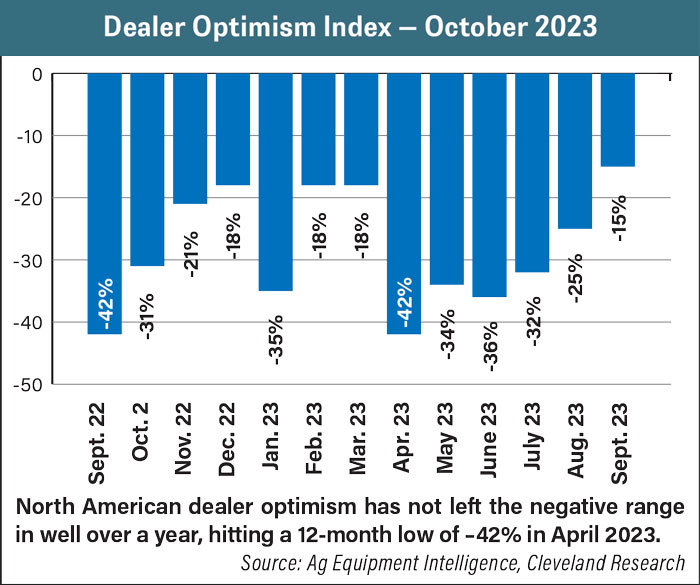One year after the first signs of downward motion in the ag equipment market began to appear in survey results, dealers are indicating 2024 will be their toughest year since the pandemic for this year’s Dealer Business Outlook & Trends report. A combination of recovering inventories, high interest rates and general economic downturn has dealers preparing to weather the storm.
Last year’s survey saw a notable drop-off in optimism in dealers’ new and used wholegoods revenue forecasts, while parts and service revenue forecasts hit record highs. While dealers are no longer facing the equipment shortages that dampened their optimism in the last report, price increases remain a factor despite falling from 2022 peaks.
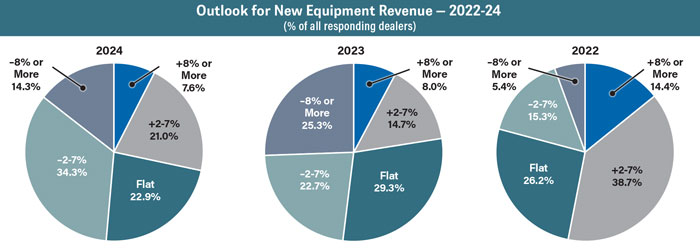
For 2024, the percentage of dealers forecasting increases and the percentage forecasting declines both rose year-over-year. Almost 23% of dealers are forecasting no change at all, the lowest percentage in the last 3 reports. Source: Source: Dealer Business Outlook & Trends reports
Optimism remains to some degree based on healthy farmer financials and solid commodity prices. However, the question of how much cash farmers will bring into 2024 has yet to be answered.
Mixed 2024 Wholegoods Outlook
New wholegoods revenue projections were once again mostly negative in this year’s report as demand declines. Nearly half of all surveyed dealers (48.6%) are forecasting some degree of new wholegoods revenue decline in 2024, just above the 48% who said the same in the previous report. The percentage forecasting a decline of 8% or greater, however, declined year-over-year from 25.3% to 14.3%.
At the same time, a little over a quarter (28.6%) are forecasting a revenue increase of 2% or more, up from 22.7% who forecast an increase for 2023 in the previous report. Some 7.6% are forecasting an increase of 8% or more in 2024 new wholegoods revenue (down from 8% who said the same in the previous report).
In the U.S., 27.8% of surveyed dealers are forecasting new wholegoods revenue to increase vs. 21.8% in the last report. At the same time, the percentage of U.S. dealers forecasting new wholegoods revenue to decline also rose to 50% vs. 49.3%.
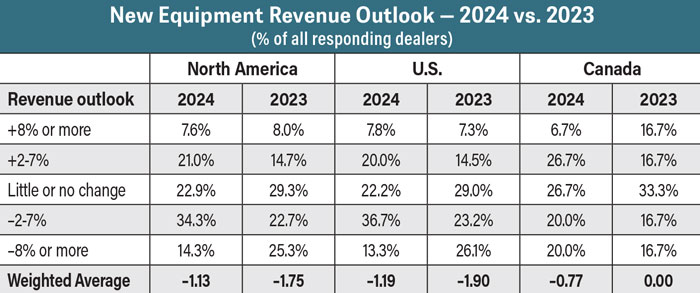
By country, U.S. dealers were less optimistic about new equipment revenue growth in 2024, with 27.8% expecting an increase of 2% or more vs. 33.4% of Canadian dealers. Source: Dealer Business Outlook & Trends reports
Canadian dealers were more optimistic than their U.S. counterparts once again, with 33.4% forecasting some degree of new wholegoods revenue increase for 2024, the same percentage who forecast increase for 2023 in the previous report. Some 40% of Canadian dealers this year, however, forecast revenue to be down 2% or more year-over-year, up from 33.4% who said the same for 2023.
The outlook on used equipment revenue growth was up slightly year-over-year as well. Some 32.7% of dealers are forecasting an increase, up from 31.5% in the last report. Slightly more dealers held a neutral view on used revenue at 38.5%, up from 37%.The percentage of dealers forecasting declines in their used equipment revenue dropped to 28.8% in this year’s report vs. 31.5% who said the same for 2023.
Some 32.6% of U.S. dealers forecast their used equipment revenue up next year vs. 31.4% who said the same in the previous report. Another 28.1% forecast their revenue down for 2024, down from the 32.8% who said the same for 2023. The percentage forecasting used revenue down 8% or greater dropped from 19.4% to 11.2%.
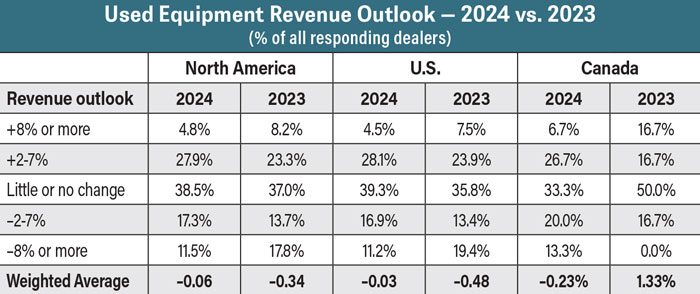
Fewer Canadian dealers are forecasting little to no change in their used equipment revenue for 2024 at 33.3% vs. 39.3% of U.S. dealers saying the same. Source: Dealer Business Outlook & Trends reports
As with new wholegoods revenue, a greater percentage of Canadian dealers forecast increases in used wholegoods revenue than their U.S. counterparts, with 33.4% forecasting some degree of growth, while 33.3% gave flat forecasts. The percentage forecasting declines however, increased from 16.7% to 33.3%.
A little over 73% of dealers are forecasting at least a 2% increase in their parts revenue for next year, below the 75.3% who were saying the same in the last report. Some 10.6% are forecasting increases of 8% or more or more, less than half the 26% who said the same for 2023. Just 1.9% of dealers forecast a decline in parts revenue, down from the previous high of 5.5% who forecast a decline for 2023.
Dealer, Farmer Sentiment Remains Low
Dealer and farmer sentiment came in low in the previous Dealer Business Outlook & Trends report and more or less stayed there over the course of 2023. Whereas before that drop in sentiment came from lingering supply chain issues and low inventory levels, now pessimism is driven by declining sales and low early orders.
In Ag Equipment Intelligence’s latest Dealer Optimism Index, net dealer sentiment came in at –18%, the 28th negative reading in a row. In the most recent reading, 10% of dealers were more optimistic in October than they had been in the previous month. The accelerated growth in new and used inventories, inflation/rising interest rates and recessionary pressures are causing concern among dealers.
Multiple dealers pointed to customers pulling back on their spending, with one Canadian dealer saying, “Customers appear more hesitant to accept late deliveries and are slow to pay for it.” Another dealer from the Lake States said, “High interest rates, low commodity prices and high fuel prices are impacting farmer sentiment and spending.”
Other dealers referenced the need for OEM involvement, with one Appalachian dealer saying, “We need OEMs to increase incentive programs to help move equipment. Our new and used equipment levels are increasing month-over-month.” Another dealer in the Corn Belt said, “There are several 0% financing programs resurfacing, but the cash discount outweighs all other discounting programs.”
Inventory Concerns. High inventories will be a key concern for 2024. As one dealer in the Northeast put it, “We are nervous our fourth quarter used inventory will be too high after we get all the trades in.” Another Pacific dealer said, "We are now able to fill around 80% of retail orders out of inventory.”
Dealers’ inventories have finally moved out of negative territory according to the latest Dealer Sentiments report, where a net 22% of dealers reported new inventories too high (39% too high, 43% in line, 17% too low). This was the third “too high” reporting since May 2020.
Only a net 4% of dealers reported used equipment inventory as too low (22% too high, 51% in line, 26% too low) in October. By equipment category, a net 35% of dealers reported used combine inventories as too high in the month (43% too high, 48% in line, 9% too low), but a net 33% of dealers report used high horsepower tractor inventories too low in October (8% too high, 50% in line, 42% too low).
Pricing. The rate of price increases has dropped since 2022 but remains a negative factor on dealer sentiment. New equipment price contribution was up around 3% on average in October, similar to the last couple of months. Dealer commentary suggests the rate of increases has slowed in the last few months as OEMs return to more normalized annual price increases and potential financing incentives resurface.
By equipment segment, used row-crop tractor pricing was up 1% year-over-year in October, used 4WD tractor pricing was flat and used combine pricing was down 2%. Used compact and utility tractor pricing came in at –2% and 0%, respectively. Customer Concerns. Farmer sentiment has remained more or less steady over the last 12 months and below peaks seen in 2020-21. The Ag Economy Barometer update from Purdue University on Nov. 7, 2023, showed a reading of 110, down from 112 in the previous report.
“The modest improvement in farmer sentiment resulted from farmers’ improved perspective on current conditions on their farms as well as their expectations for the future,” the report said. “Farmers in this month’s survey were a bit less concerned about the risk of lower prices for crops and livestock and felt somewhat better about their farms’ financial situation than a month earlier.”
Additionally the Farm Capital Investment Index from the same report hit its lowest reading of the year at 35 (vs. 31 in the previous report). “In October, nearly 8 out of 10 respondents said it was a bad time to make large investments in their farm operation, while just 13% of farmers responding to the October survey said it was a good time to make large investments,” the report said. “Among those who said it’s a bad time to invest, the most commonly cited reason was rising interest rates, chosen by 41% of respondents. In July and August ‘strong cash flows’ was the most commonly chosen reason for saying it’s a good time to make investments. However, that slipped to 32% in September and fell again in October to just 24%.”
In the U.S., dealers’ overall parts revenue optimism was up slightly year-over-year, with 74.2% forecasting an increase vs. 73.2% in the previous report. However, the percentage forecasting an 8% or more increase declined notably from 26.9% to just 9%. Just 2.3% of U.S. dealers forecast any kind of parts revenue decline, an improvement from 6% who said the same for 2023.
Two-thirds of Canadian dealers are forecasting an increase in parts revenue for next year with none forecasting a decline, down from 100% of dealers in the previous report forecasting an increase.
Just under 71% of dealers are forecasting a service revenue increase for 2024, down from 74.3%. Within this percentage, 13.6% are forecasting an 8% or more increase for 2024 vs. 21.6% who forecast the same increase one year ago. Just 2.9% of dealers forecast a decline in service revenue for 2024, an improvement from the 5.5% in the last report.
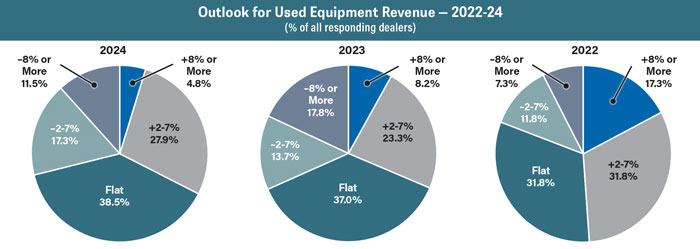
Used wholegoods revenue forecasts for 2024 saw 4.8% of dealers forecast an increase of 8% or more, the lowest percentage in the this category in the last 3 years. Source: Dealer Business Outlook & Trends reports
U.S. dealers saw a slight decline in their service revenue optimism, with 70.5% forecasting an increase for next year vs. 72.1% who said the same in the previous report. There was a decline in the percentage forecasting growth of 8% or more, however, from 22.1% to 11.4%. A little over 73% of Canadian dealers forecast an increase in service revenue for 2024, with 26.7% forecasting an increase of 8% or more. This doesn’t beat the previous forecasts, however, when all surveyed Canadian dealers forecast an increase in service revenue for 2023.
Dealer 2023 Revenue & Gross Margin Estimates vs. Last Year’s Forecasts
Dealers’ current estimates on their 2023 new wholegoods revenue were notably more positive than their previous forecast, particularly in the percentage of dealers reporting growth. The most recent report saw 57.3% of surveyed dealers estimate their new equipment revenue up 2% or more in 2023, beating last year’s percentage who forecast an increase (22.7%). The percentage estimating growth of 8% rose from 8% to 30.9% of dealers estimating this as their 2023 new wholegoods revenue increase. Some 26.4% of dealers reported a decline in 2023 new wholegoods revenue of 2% or more, almost half the 48% who had forecast the same. The percentage of dealers estimating a new wholegoods revenue decline of 8% or more came in at 13.2%, below the 25.3% who forecast the same in the last report.
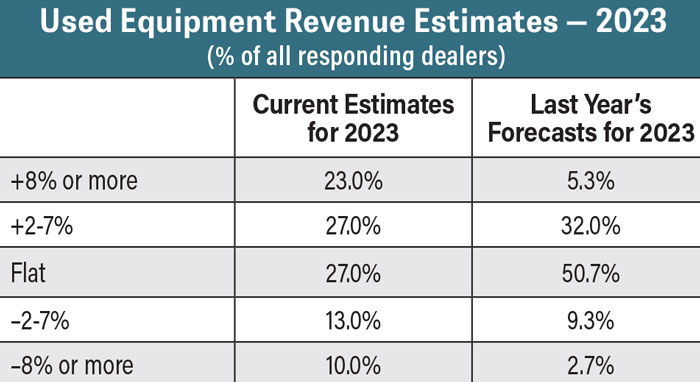
Half of surveyed dealers estimate their used equipment revenue will be up 2% or more in 2023, above the 37.3% who forecast the same in the previous report. Source: Dealer Business Outlook & Trends reports
The used equipment situation saw estimates more split than last year’s forecasts showed. Exactly 50% of dealers estimate their used wholegoods revenue in 2023 will be up 2% or more vs. the 38.3% who forecast an increase. At the same time, 23% estimate a decline of 2% or more, up from the 12% who forecast a decline. Notably, 23% reported an increase of 8% or more (up from 5.3% who forecast this increase) and 10% estimated a decline of 8% or more.
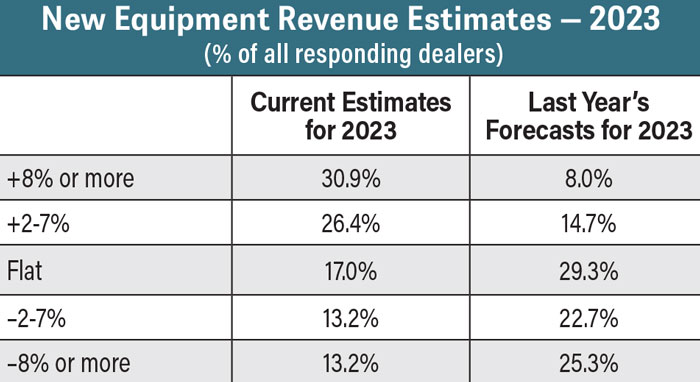
Dealers’ new equipment revenue estimates for 2023 were above projections made in the previous report, with 57.3% estimating they’ll finish up 2% or more vs. just 22.7% forecasting that last time. Source: Dealer Business Outlook & Trends reports
Looking at aftermarket revenue, estimates for 2023 are closely in line with previous forecasts. Some 78% of dealers are estimating increases in parts revenue of 2% or more vs. 75.3% who had previously forecast this increase. Another 26% had forecast an increase in parts revenue of 8% or more, whereas now 33% are estimating this is how their parts revenue will finish in 2023.
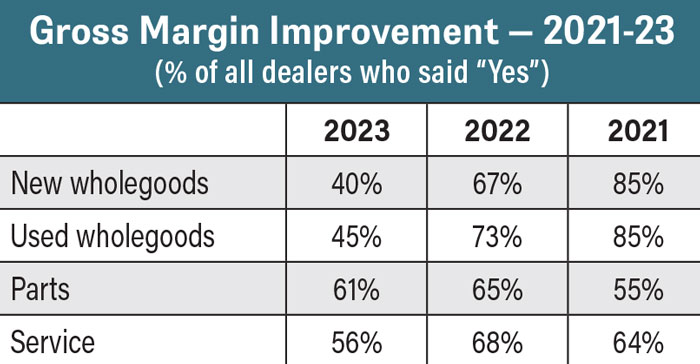
The percentage of dealers reporting improvements in their gross margins was down year-over-year for 2023 in all categories. Source: Dealer Business Outlook & Trends reports
On the service side, 71% of dealers are estimating they’ll be up for 2023, down slightly from 74.3% who had forecast the same. Here the percentage of dealers now estimating an increase of 8% or more again surpasses the forecast for this growth category: 33% now vs. 21.6% in the previous report's forecast.
For gross margins, estimates are down across the board year-over-year. Just 40% of dealers said their new wholegoods margins would improve in 2023 down from 67% who said the same about 2022 and the lowest percentage among categories. Another 45% said the same about their 2023 used wholegoods margins, down from 73% who said the same last year. A greater percentage of dealers said their parts and service gross margins would improve in 2023 (61% and 56%) than did for wholegoods, a trend not seen in 2022 or 2021 estimates.

Dealers’ estimates for their 2023 parts and service revenue were closely in line with the forecasts made in the last report, though more dealers estimated 8% or more revenue increases than forecast them earlier. Source: Dealer Business Outlook & Trends reports
Equipment Prices & Early Orders
Some 94.3% of dealers expect a price increase from their mainline supplier next year, down slightly from 96.3% in the last report. However, among dealers forecasting an increase, fewer dealers bet on a higher increase than did in the previous forecasts for 2023.
Just 3.8% of dealers expect a price increase of 10% or more from their OEM next year, well below the 24.1% who said the same in the last report. More dealers this year were also forecasting a smaller increase of 1-3% (58.1%) than did so for the previous report (17.6%). At the same time, the 4-6% and 7-9% increase categories saw declines in the percentage of dealers selecting them, coming in at 26.7% and 5.7% for 2024, respectively.

5.7% of dealers are forecasting no new equipment price increases next year, the highest percentage in the last 3 years. Source: Dealer Business Outlook & Trends reports
Just 15% of surveyed dealers reported an increase in early orders for 2024, down from 50.9% who said the same in the previous report and the smallest percentage seen in the last 5 years. Another 56.1% are reporting declines for 2024, the highest percentage in the last 5 years and an increase from 26.8% in the previous report. Among the dealers reporting declines in early orders, 15% are reporting a decline of more than 10%, another 5-year high.
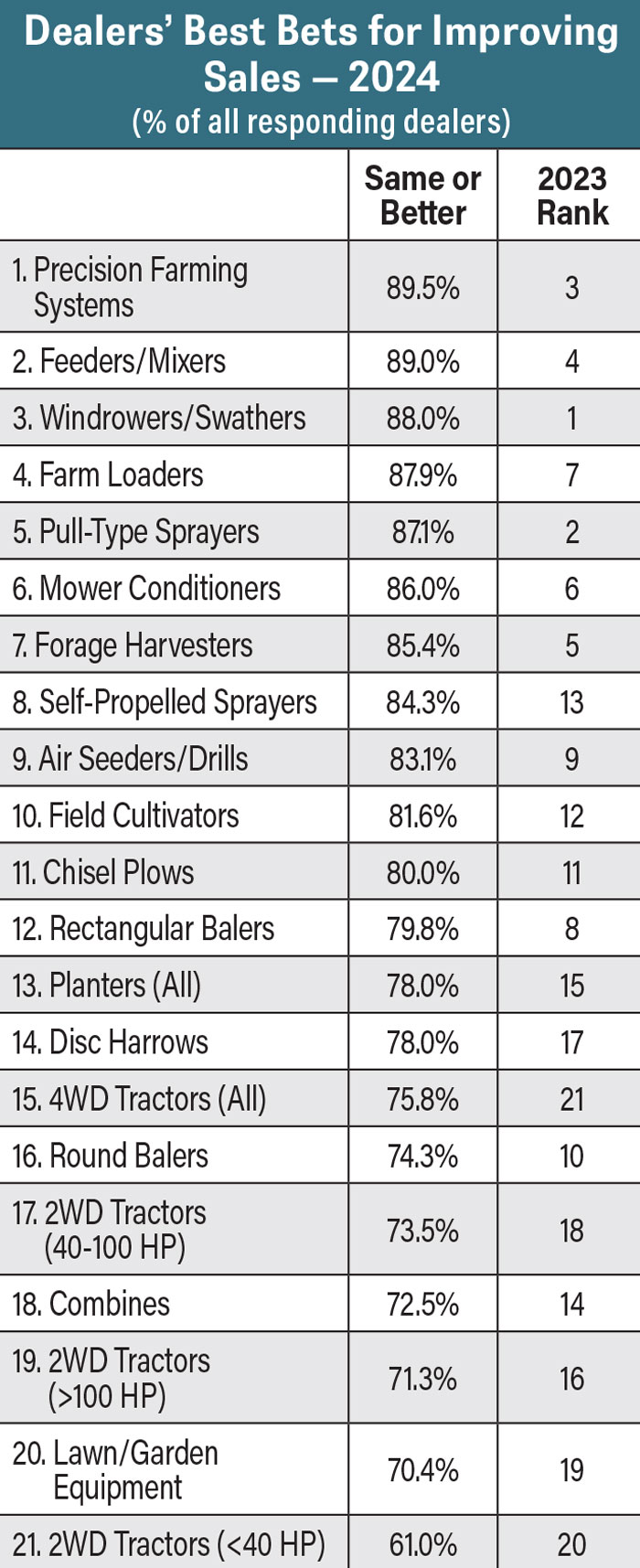
Precision farming systems were dealers’ best bet for improving unit sales, up from #3 last year. Source: Dealer Business Outlook & Trends reports
Negative Tractor Sales Outlook
Dealers’ tractor and combine unit sales outlooks for 2024 were down for large ag equipment categories, with only compact tractor sales showing a forecast increase. The most dramatic overall decrease for North America was in combines, where the percentage of dealers forecasting a 2% or more increase fell from 20% in the last report to just 13.2% this year, the lowest percentage among equipment categories. 40-100 horsepower tractors showed the smallest decline, with the percentage of dealers betting on sales growth falling from 28.9% to 24.5% this year.
The highest percentage of dealers forecasting an increase was seen in over 100 horsepower tractors at 29.7%, down year-over-year from 37.2%. For 4WD tractors, 26.3% of dealers forecast an increase in sales for 2024, down as well from 31.5%.
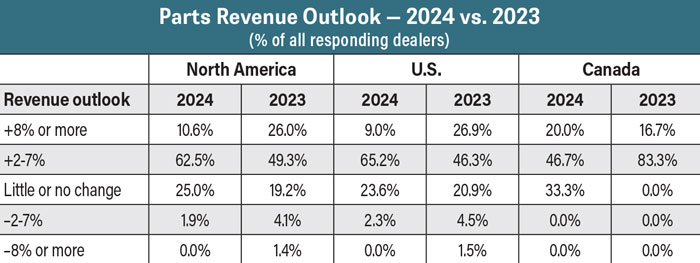
A lower percentage of Canadian dealers (66.7%) forecast an increase of 2% or more in 2024 parts revenue than U.S. dealers (74.2%) did. Source: Dealer Business Outlook & Trends reports
The second-most selected category for sales growth among tractors and combines was compact tractors at 29%, up from 21.1% in the last report.
Outside of just tractors and combines, precision farming systems were dealers’ top overall pick for unit sales growth in 2024, with 89.5% of dealers forecasting their sales to improve or remain the same as 2023 sales. This was followed by feeders and mixers at 89% and windrowers and swathers at 88%.
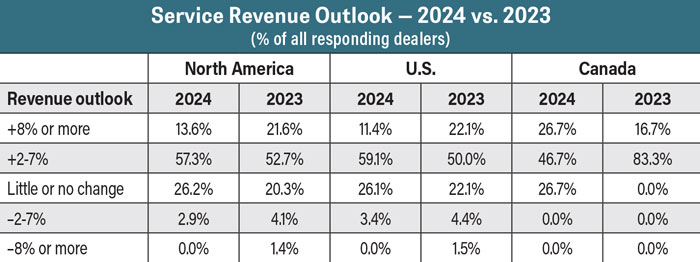
Some 73.4% of Canadian dealers are forecasting service revenue to be up 2% or more in 2024, above the 70.5% of U.S. dealers who are forecasting the same. Source: Dealer Business Outlook & Trends reports
Two notable changes in ranking this year were 4WD tractors as the 15th best bet for improving sales in 2024 (up from the 21st and least selected equipment category for 2023) and self-propelled sprayers as the 8th best bet (up from the 13th best bet for 2023). Other tractor horsepower categories and combines once again gathered near the bottom as the least likely category for improving unit sales.
Other notable shifts were round balers dropping to #16 from #10 in the previous report, rectangular balers falling to #12 from #8 and pull-type sprayers coming in as the 5th best bet vs. being the 2nd best bet for 2023.

Though the percentage of dealers forecasting sales growth was down year-over-year (from 37.2% to 29.7%), 100+ horsepower tractors was once again the most popular tractor category for forecasting sales growth in this year’s report. Source: Dealer Business Outlook & Trends reports
Top Concerns for 2024
Increasing interest rates topped dealers’ list of concerns for 2024 up from being dealers’ 3rd biggest concern in the previous report. Dealers ranked 22 different issues and concerns, with rankings determined by the percentage of dealers that are both “concerned” and “most concerned.” Technician availability remained the #2 concern, with 66.7% of dealers saying they were most concerned about this issue. Farm input costs came in at #3 for 2024, unchanged in ranking from the last report. The increasing cost of new equipment (62.6% most concerned) and farm commodity prices (47.4% most concerned) rounded out the top 5. Notably, the increasing cost of new equipment dropped from being the top concern in the previous report.
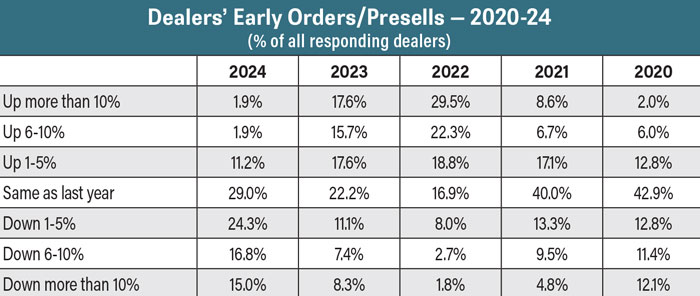
The percentage of dealers reporting early orders down more than 10% in 2024 came in at 15%, the highest this percentage has been in the last 5 years. Source: Dealer Business Outlook & Trends reports
Other notable changes included financing availability as the 14th concern vs. being the 5th concern for 2023. Energy and fuel costs dropped to #11 from #6, and healthcare affordability was the 6th highest-rated concern, up from the 12th highest-rated concern in the last report. Concerns about 2024 being an election year was ranked #12. The lowest percentage of dealers were concerned or most concerned about manufacturer consolidation (44.7%).
How Concerned Should the Industry Be About 2025?
2024 will certainly have its challenges. However, Lead Economist for Grains and Oilseeds at CoBank Tanner Ehmke thinks where ag equipment manufacturers should really be looking is 2025.
In a recent interview with Ag Equipment Intelligence, Ehmke says farmers are in a good financial position heading into 2024 with solid cash reserves. At the same time, he acknowledges commodity prices are coming down as production costs are going up.
“The farmer is carrying over a fair amount of income from last year,” he says. “They’re very reluctant sellers this year. So they’re going to have cash still sitting in the bank account if they haven’t spent it already.”
“2022 was record high net farm income. Farmers do not need cash, so they’re delaying sales of their grain into next year to defer income to lower their taxable income.”
In 2025, however, Ehmke forecasts lower farmer cash reserves, which will make equipment replacement a harder sell.
“I’d be concerned about 2025 because that’s when some of their cash reserves are going to be depleted, and then it’s going to be hard for them to justify replacing their machinery,” he says. “Probably 2024 is not going to be a bad year. I would imagine farmers are still carrying over a ton of cash. It’s going to be in 2025, that’s when you’d be concerned.”
Hiring & Investments for 2024
Dealers’ hiring plans for 2024 did not change notably from their previous plans for 2023. The most popular category was once again service technicians, with 85% of dealers planning to hire technicians in 2024 vs. 84.8% who were planning to hire in 2023. The second-most selected category for hiring was once again the parts department, with 43% planning to hire, down slightly year-over-year from 45.7%.
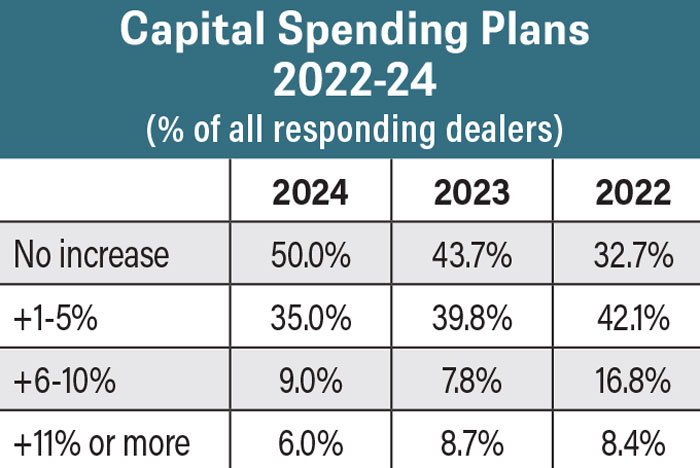
Half of dealers are planning no increase in their CAPEX for 2023, the highest percentage seen in the last 4 years. Source: Dealer Business Outlook & Trends reports
The fewest dealers plan to add to their corporate/administration staff (unchanged from the previous report), where 12% of dealers are planning to add, down from 17.7% in the previous report. This was also the category in which dealers were most likely to reduce staffing, with 6% planning to do so in 2024.
Among areas they will invest in, almost 63% of dealers indicated they’d be putting money into their shop and service departments in 2024, its 4th year in a row as the most popular option. The second-most popular option was investing in mobile service vehicles at 48.5%, though this is the second-lowest this percentage has been in 5 years.
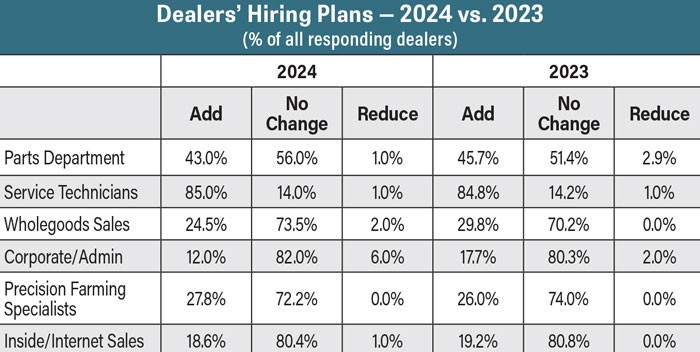
Service technicians remained the most sought-after category of employees that dealers are looking to hire for the 4th year in a row, followed by the parts department at 43%. Source: Dealer Business Outlook & Trends reports
Another 39% of dealers will invest in their showrooms and 37% said they’ll be investing in their business information systems (the least popular category for the first time in 4 years).
For 2024, 50% of dealers don’t plan to increase their capital spending, the highest this percentage has been in 5 years. Another 35% are planning to increase capital spending 1-5%, which is a 5-year low for this category. Just 9% are forecasting an increase of 6-10% and another 6% are planning to increase their capital spending by 11% or more in 2024.

Shop & service investments remained the most popular category for dealer investment for the fourth year in a row. Source: Dealer Business Outlook & Trends reports

